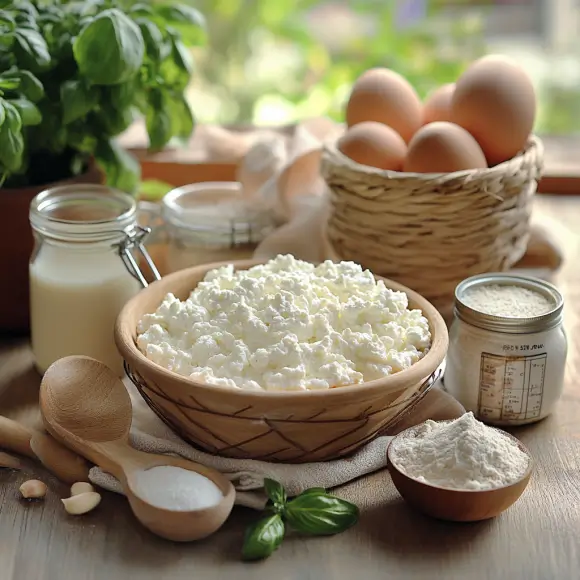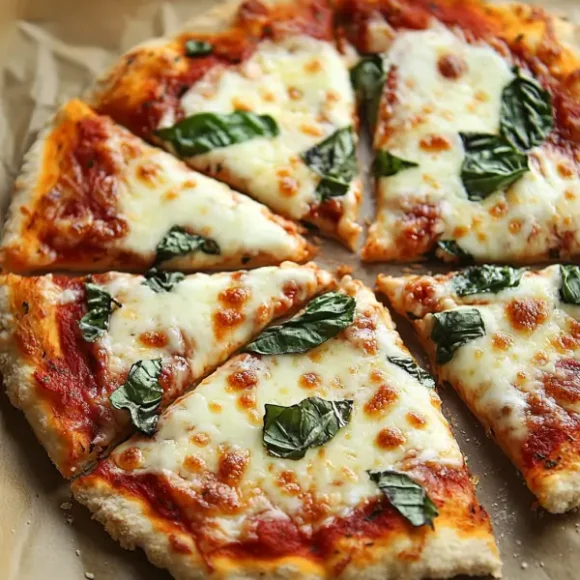- Introduction to Cottage Cheese Pizza Crust: A Game-Changing Healthy Alternative
- What is Cottage Cheese Pizza Crust? Exploring the Benefits of a Protein-Packed Base
- The Nutritional Benefits of Cottage Cheese Pizza Crust: A Healthier Pizza Option
- Ingredients Overview for Cottage Cheese Pizza Crust: What You Need to Get Started
- How to Make Cottage Cheese Pizza Crust
- Customizing Your Crust
- Baking Tips and Tricks
- Cottage Cheese Substitutes
- Pairing Pizza Toppings
- Health Comparisons
- Common Mistakes to Avoid
- FAQs:
- Conclusion
Introduction to Cottage Cheese Pizza Crust: A Game-Changing Healthy Alternative
Pizza lovers are always on the lookout for healthier yet delicious alternatives to traditional doughs. In this context, cottage cheese pizza crust emerges as a game-changer for those who crave pizza but also want a more nutritious base. Not only does this crust significantly cut down on carbs, but it also delivers a high-protein, versatile option that effortlessly fits into various dietary goals. For instance, it’s perfect for individuals following a low-carb or keto diet, those seeking gluten-free solutions, or even food enthusiasts experimenting with creative and wholesome recipes. As a result, this crust provides a satisfying and unique twist to your pizza nights that’s both health-conscious and indulgent.
In this article, we’ll try everything you need to know about cottage cheese pizza crust. To start with, we’ll discuss its numerous benefits and why it’s gaining popularity as a healthier alternative. Following that, we’ll walk you through simple preparation methods that guarantee a perfect crust every time. Additionally, we’ll share pairing ideas that bring out the best flavors and textures to complement this unique base. Finally, we’ll tackle common questions and challenges, providing tips to help you avoid pitfalls and master the art of making cottage cheese pizza crust.
With all that in mind, prepare to embark on a culinary journey that redefines your pizza experience. Whether you’re a health-conscious foodie, a busy home cook looking for quick and nutritious options, or someone seeking to diversify their meals, this guide has something for everyone. So, let’s not waste another moment—dive in, and discover your new favorite way to enjoy pizza like never before!
What is Cottage Cheese Pizza Crust? Exploring the Benefits of a Protein-Packed Base
To begin with, cottage cheese pizza crust is a healthier alternative to traditional pizza dough. It’s made primarily from cottage cheese, eggs, and a binding agent such as almond or coconut flour. Unlike regular dough, which relies heavily on wheat or other grains, this crust is protein-rich, lower in carbohydrates, and entirely gluten-free.
Moreover, the process of making this crust is simple yet rewarding. By blending cottage cheese with a few other ingredients and baking it, you can create a sturdy yet flavorful base for any toppings you love. Ultimately, it’s not just about meeting dietary restrictions—it’s about enjoying a new and delicious way to eat pizza.
If you’re a fan of experimenting with healthy snacks, you might also enjoy trying cottage cheese chips, another creative use of this versatile ingredient.
The Nutritional Benefits of Cottage Cheese Pizza Crust: A Healthier Pizza Option
Before we discuss how to make the crust, it’s essential to understand its nutritional advantages. In comparison to traditional pizza bases, cottage cheese pizza crust stands out for several reasons:

High Protein Content: Cottage cheese is packed with protein, which is vital for muscle repair and maintaining satiety.
Low in Carbs: For those on low-carb or ketogenic diets, this crust is a perfect fit.
Rich in Calcium: Thanks to its dairy base, this crust supports bone health.
Low-Calorie Option: Unlike calorie-dense traditional crusts, it offers a lighter alternative.
Gluten-Free: Those with celiac disease or gluten sensitivities can enjoy it worry-free.
For topping ideas, check out recipes like ham jalapeño biscuits for inspiration on combining bold flavors.
Ingredients Overview for Cottage Cheese Pizza Crust: What You Need to Get Started
To prepare cottage cheese pizza crust, you’ll need just a few key ingredients. Let’s take a closer look:

Cottage Cheese: The main ingredient that provides creaminess and structure. You can choose full-fat for richness or low-fat for a lighter option.
Eggs: They act as the glue, holding all the ingredients together.
Almond or Coconut Flour: These flours give the crust its firmness and texture.
Seasonings: Garlic powder, oregano, basil, and salt improve the overall flavor.
Baking Powder: This adds a bit of lift to the crust for a better texture.
Additionally, you can include optional ingredients such as:
- Grated Parmesan for extra cheesiness.
- Crushed red pepper flakes for a hint of heat.
How to Make Cottage Cheese Pizza Crust
Now that we’ve covered the ingredients, let’s move on to the step-by-step process for creating cottage cheese pizza crust. Follow these simple instructions:
- Preheat Your Oven: To start, set your oven to 400°F (200°C). Meanwhile, line a baking sheet with parchment paper to prevent sticking.
- Blend the Ingredients: Next, combine the cottage cheese, eggs, almond flour, baking powder, and seasonings in a food processor. Blend until smooth.
- Spread the Mixture: After blending, pour the batter onto the baking sheet. Then, use a spatula to spread it evenly into your desired shape.
- Bake the Crust: Bake the crust for 12–15 minutes, or until the edges turn golden brown. This pre-bake step is crucial to guarantee the crust holds up under toppings.
- Add Your Toppings: Once the crust is baked, remove it from the oven and add your chosen toppings. Return it to the oven for an additional 8–10 minutes.
Finally, allow the pizza to cool slightly before slicing and serving. This method guarantees your crust is both flavorful and structurally sound.
Customizing Your Crust
One of the best features of cottage cheese pizza crust is its versatility. You can adapt the recipe in many ways to suit your preferences. For instance:
- Flour Alternatives: If you prefer, substitute almond or coconut flour with oat or chickpea flour for different textures and flavors.
- Herbs and Spices: Add rosemary, thyme, or paprika to create a crust with unique seasoning.
- Cheese Additions: Mixing in shredded mozzarella or cheddar can make the crust cheesier.
- Shape Variations: For convenience, make mini crusts or personal-sized pizzas.
By customizing your crust, you can tailor it to fit your exact taste and dietary requirements.
Pair it with a side of baked cottage cheese for a protein-rich, satisfying meal.
Baking Tips and Tricks
To guarantee your cottage cheese pizza crust turns out perfectly, keep these helpful tips in mind:
- Use Parchment Paper: This prevents the crust from sticking and makes cleanup easy.
- Spread Evenly: An even layer guarantees the crust bakes uniformly.
- Monitor Baking Time: Since ovens vary, keep a close eye on the crust to avoid overbaking.
- Allow to Cool Slightly: Letting the crust cool helps it maintain its structure when toppings are added.
- For Extra Crispiness: Broil the crust for the final 2–3 minutes to achieve a crisp outer layer.
These tips will significantly improve the quality of your homemade pizza crust.
Cottage Cheese Substitutes
While cottage cheese is the key ingredient, you might not always have it on hand. Fortunately, there are several substitutes you can use:
- Greek Yogurt: Offers similar tanginess and creaminess.
- Ricotta Cheese: Slightly sweeter but works as a great alternative.
- Cream Cheese: Rich and flavorful, though higher in fat.
- Silken Tofu: For a vegan option, this provides a comparable texture.
Each substitute changes the flavor profile slightly, giving you a chance to experiment.
Pairing Pizza Toppings
Choosing the right toppings can improve your cottage cheese pizza crust. Here are some pairing ideas to inspire you:
- Classic Margherita: Keep it simple with fresh tomatoes, basil, and mozzarella.
- Protein-Packed: Try grilled chicken, spinach, and feta for a hearty meal.
- Vegetarian Delight: Combine bell peppers, mushrooms, olives, and onions for a veggie-packed pizza.
- Bold Flavors: Experiment with BBQ sauce, shredded pork, and jalapeños.
- Breakfast Pizza: Top with scrambled eggs, bacon, and cheddar.
By pairing complementary toppings, you’ll create a pizza that’s not only nutritious but also bursting with flavor.
Health Comparisons
To truly appreciate cottage cheese pizza crust, it’s helpful to compare it to traditional crusts:
- Fewer Calories: It’s lower in calories, making it ideal for weight management.
- Lower Carbohydrates: Perfect for those on low-carb or keto diets.
- Higher Protein: Supports muscle health and keeps you fuller longer.
- Customizable Fat Content: Use full-fat or low-fat cottage cheese to control fat levels.
Given these benefits, it’s clear why this crust is a superior option for health-conscious eaters.
Common Mistakes to Avoid
To guarantee your crust turns out perfectly, avoid these common mistakes:
- Skipping the Pre-Bake: Failing to pre-bake will result in a soggy crust.
- Overloading with Toppings: Too many toppings can make the crust collapse.
- Using Watery Cottage Cheese: Always strain excess liquid for the best results.
- Ignoring Measurements: Precision is key to achieving the right texture.
Being mindful of these potential pitfalls will lead to a successful and satisfying crust.
FAQs:
Does cottage cheese work on pizza?
Yes, cottage cheese works wonderfully on pizza! Not only can it be used as a topping for added creaminess and protein, but it can also serve as the primary ingredient in a cottage cheese pizza crust. When blended with eggs and a binding agent like almond or coconut flour, cottage cheese forms a delicious and sturdy crust that complements any toppings you choose. Its tangy flavor and creamy texture make it a versatile option for pizza lovers looking to try something unique and nutritious.
What is the healthiest crust for pizza?
The healthiest pizza crust depends on your dietary needs and preferences, but some top options include:
- Cottage Cheese Pizza Crust: High in protein, low in carbs, and gluten-free, it’s ideal for health-conscious eaters.
- Cauliflower Crust: A popular low-carb, vegetable-based option that’s high in fiber.
- Whole Wheat Crust: Offers more fiber and nutrients compared to refined white flour crusts.
- Almond Flour Crust: Perfect for keto or gluten-free diets, with healthy fats and low carbs.
Among these, cottage cheese pizza crust stands out for its high protein content and simplicity to make.
What is a good substitute for pizza dough
If you’re looking to replace traditional pizza dough, here are some great alternatives:
- Cottage Cheese Pizza Crust: A protein-packed, gluten-free option.
- Cauliflower Crust: Made from grated cauliflower, eggs, and cheese, it’s a low-carb favorite.
- Portobello Mushroom Caps: Use large mushroom caps as a base for mini pizzas.
- Zucchini Slices: Great for bite-sized pizza snacks.
- Tortilla or Pita Bread: Quick and easy, though not low-carb or gluten-free.
These substitutes offer various textures and flavors while accommodating specific dietary preferences.
What is the best cheese for pizza crust?
The best cheese for pizza crust depends on your recipe and personal taste. For a cottage cheese pizza crust, the obvious choice is cottage cheese itself due to its creaminess and binding properties. However, other cheeses can improve flavor or texture, such as:
- Parmesan: Adds a nutty, savory flavor.
- Mozzarella: Offers stretchiness and richness.
- Ricotta: Provides creaminess and a mild flavor.
- Cheddar: Gives a sharper, more pronounced taste.
Combining these cheeses with cottage cheese can create a crust that is both flavorful and functional.
Conclusion
In conclusion, cottage cheese pizza crust is not only a nutritious choice but also a versatile and delicious alternative to traditional crusts. What’s more, its high protein content, low-carb benefits, and gluten-free nature make it a game-changer for individuals with various dietary needs. Additionally, it’s an excellent option for those seeking a healthy yet satisfying way to enjoy pizza without sacrificing flavor or indulgence.
By applying the tips and methods outlined in this guide, you’ll not only learn how to perfect this innovative crust but also gain confidence in experimenting with it. For example, you can customize your pizzas with a variety of toppings to suit your taste, making each creation uniquely your own. Over time, this simple yet transformative recipe will become a staple in your kitchen repertoire.
Moreover, this crust represents more than just a healthier option; it’s an opportunity to rethink what pizza can be. As you experiment, you’ll find that it adapts well to a variety of cooking methods and pairs wonderfully with an array of ingredients, allowing for endless creativity. In this way, it offers a guilt-free indulgence that doesn’t compromise on quality or satisfaction.
With that being said, why wait to give it a try? Whether you’re looking for a way to enjoy pizza while staying true to your health goals, hoping to accommodate dietary restrictions, or simply wanting to try a new culinary twist, this recipe is the perfect place to start. Take the leap today and discover how this cottage cheese crust can turn your ordinary pizza nights into an extraordinary, health-conscious experience. After all, healthier eating doesn’t mean giving up the foods you love—it just means finding better ways to enjoy them.


3 thoughts on “Cottage Cheese Pizza Crust: Healthy, Delicious & Easy to Make”